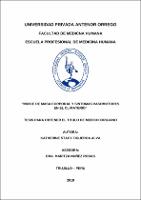Índice de masa corporal y síntomas vasomotores en el climaterio

View/
Download
(application/pdf: 732.9Kb)
(application/pdf: 732.9Kb)
Date
2019Author(s)
Figueroa Alva, Katherine Stacy
Metadata
Show full item recordAbstract
OBJETIVO: Determinar la relación entre el índice de masa corporal y los
síntomas vasomotores en mujeres climatéricas atendidas en los consultorios
médicos de los Hospitales Regional Docente de Trujillo y Belén
MATERIAL Y MÉTODOS: Se llevó a cabo un estudio de tipo analítico,
prospectivo, seccional transversal en el que se incluyeron a 368 mujeres durante
el climaterio, según criterios de selección los cuales se dividieron en 2 grupos: con
síntomas vasomotores o sin ellos; aplicándose análisis multivariado, la prueba T
de Student y la prueba estadística Chi cuadrado.
RESULTADOS: El promedio de edad fue 51,71 +- 4,49 años; significativamente
inferior en el grupo de pacientes con síntomas vasomotores respecto al grupo sin
estos síntomas (p<0.05). El puntaje promedio de los scores climatéricos
correspondiente a los síntomas circulatorios, psicológicos, generales e intensidad
del climaterio fueron significativamente superiores en el grupo de pacientes con
síntomas vasomotores con una intensidad moderada respecto al grupo sin estos
síntomas con una intensidad leve (p<0.05). El promedio de índice de masa corporal
y la frecuencia de obesidad fueron significativamente superiores en el grupo de
pacientes con síntomas vasomotores con 46,54% respecto al grupo sin estos
síntomas con 8% (p<0.05). No hubo diferencias significativas respecto al promedio
del índice cintura cadera en el grupo de pacientes con síntomas vasomotores
respecto al grupo sin estos síntomas (p>0.05). Con respecto al análisis multivariado,
el índice de masa corporal como clasificación de obesidad en relación a presencia
de síntomas vasomotores tuvo un Odds Ratio de 34,09 IC 95% (111,96) con valor
p = 0,001 mientras que en la edad se obtuvo 1,12 con valor de p= 0,007.
CONCLUSIÓN: Existe relación entre la elevación del índice de masa corporal y
la presencia de síntomas vasomotores en mujeres climatéricas. OBJECTIVE: To determine the relationship between body mass index and
vasomotor symptoms in climacteric women.
MATERIAL AND METHODS: A cross-sectional prospective study was carried
out in which 368 women were included during the climacteric, according to
selection criteria which were divided into 2 groups: with or without vasomotor
symptoms; the multivariate analysis, the student's t-test and the chi-square
statistical test are applied.
RESULTS: The average age was 51,71 +- 4,49 years; significantly lower in the
group of patients with vasomotor symptoms than in the group without these
symptoms (p <0.05). The average score of the climacteric scores corresponding to
the circulatory, psychological, general symptoms and climacteric intensity were
significantly higher in the group of patients with vasomotor symptoms classified as
moderate than in the group without these symptoms classified as mild (p <0.05).
The average body mass index and the frequency of obesity 46, 54% were
significantly higher in the group of patients with vasomotor symptoms than in the
group without these symptoms 8% (p <0.05). There were no significant differences
with respect to the average hip waist index in the group of patients with vasomotor
symptoms compared to the group without these symptoms (p> 0.05). In the
multivariate analysis the body mass index classified as obesity related to vasomotor
symptoms was 34, 09 IC 95% (111.96) (p= 0,001) while the age got 1, 12 (p=0,007).
CONCLUSION: There is a relationship between the elevation of the body mass
index and the presence of vasomotor symptoms in climacteric women.
Collections
- Medicina Humana [2969]

